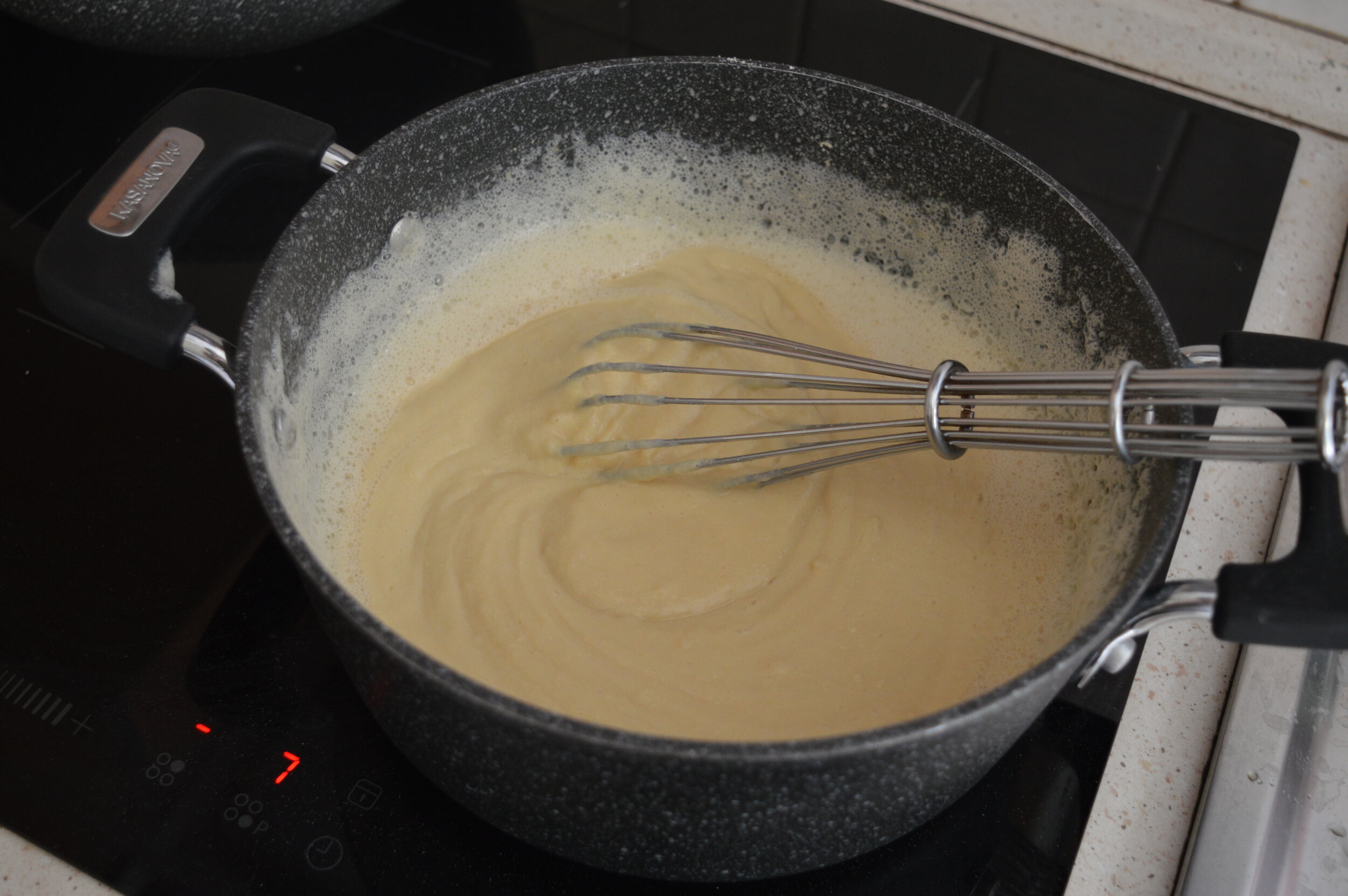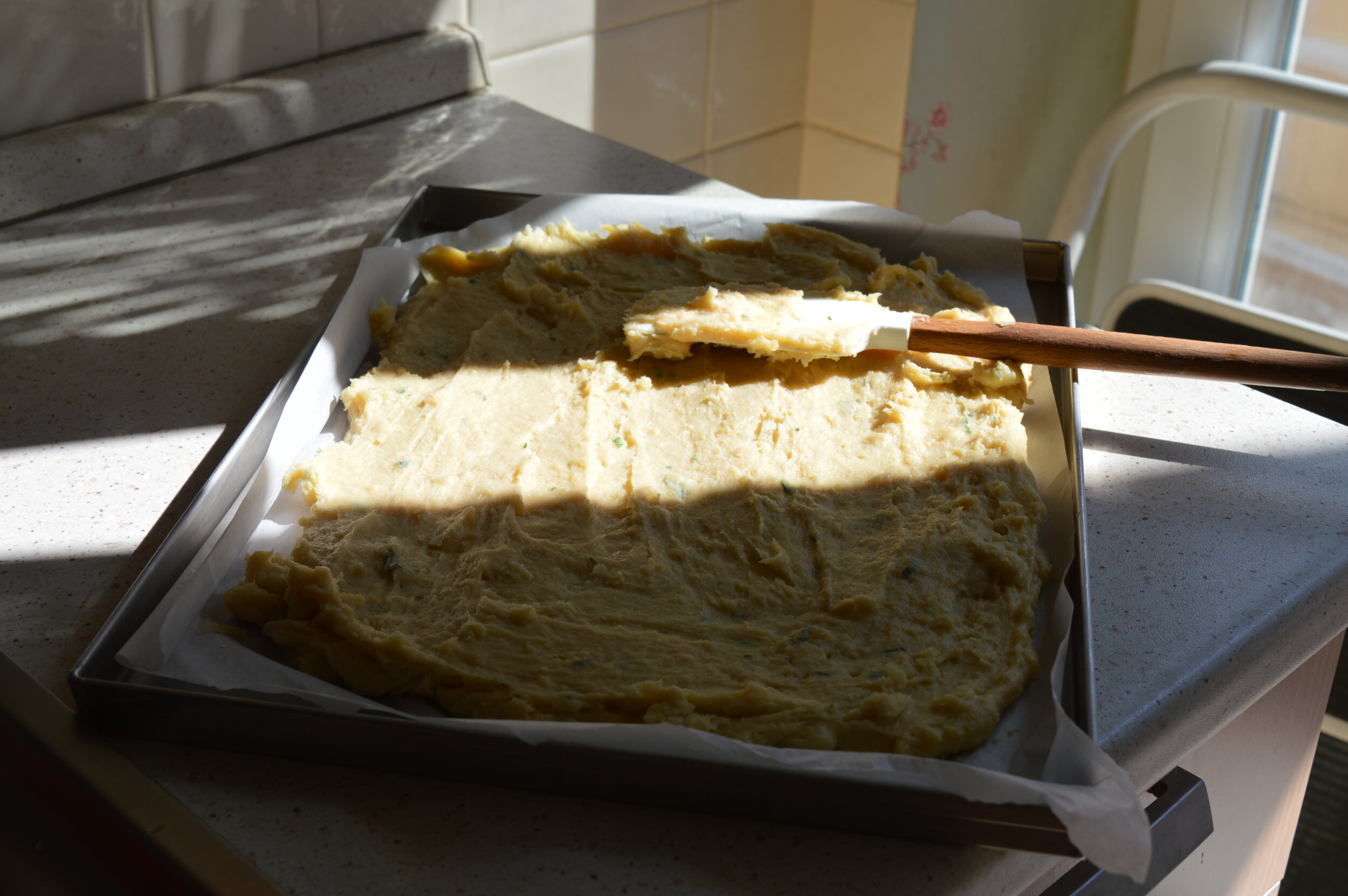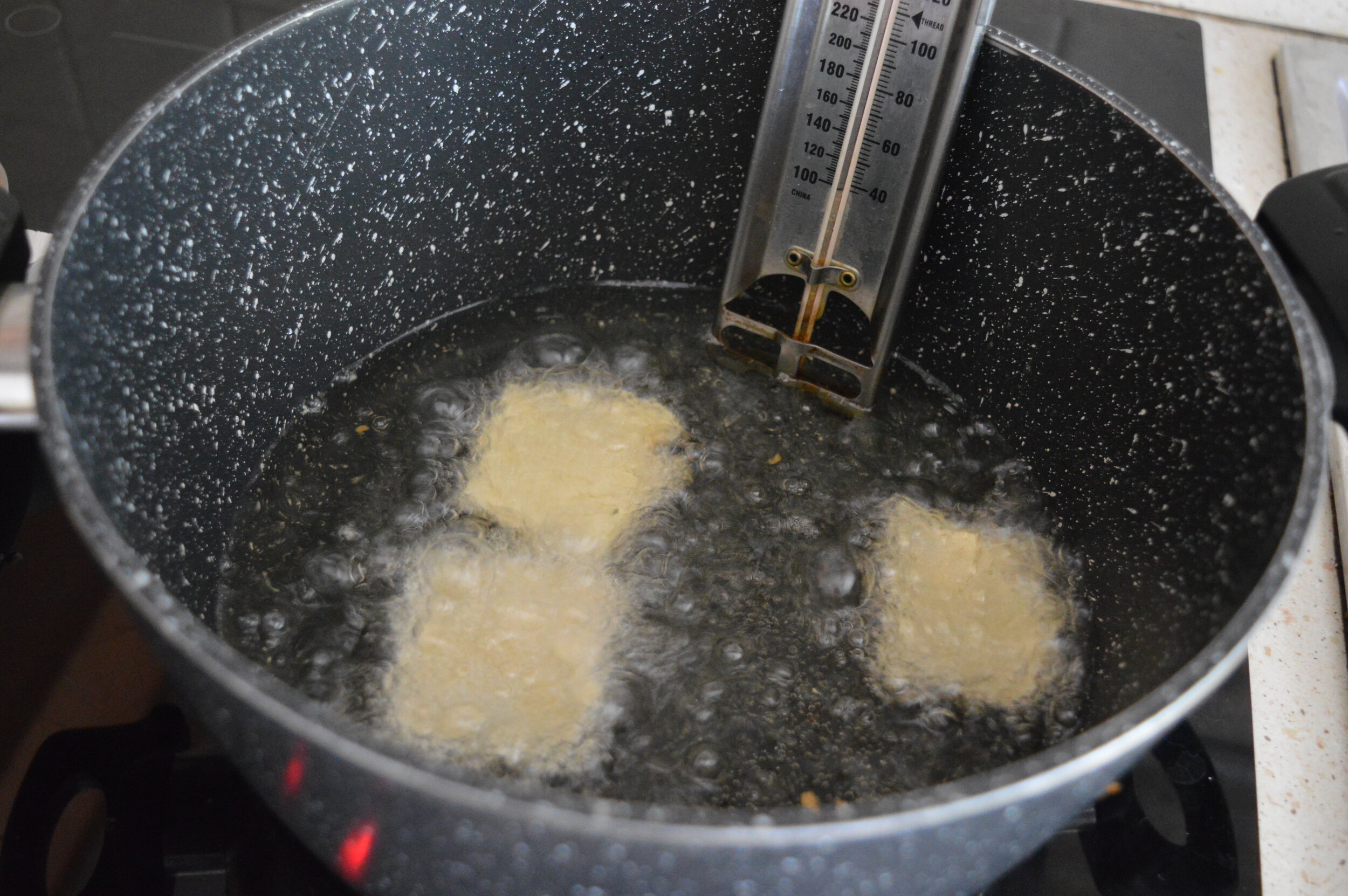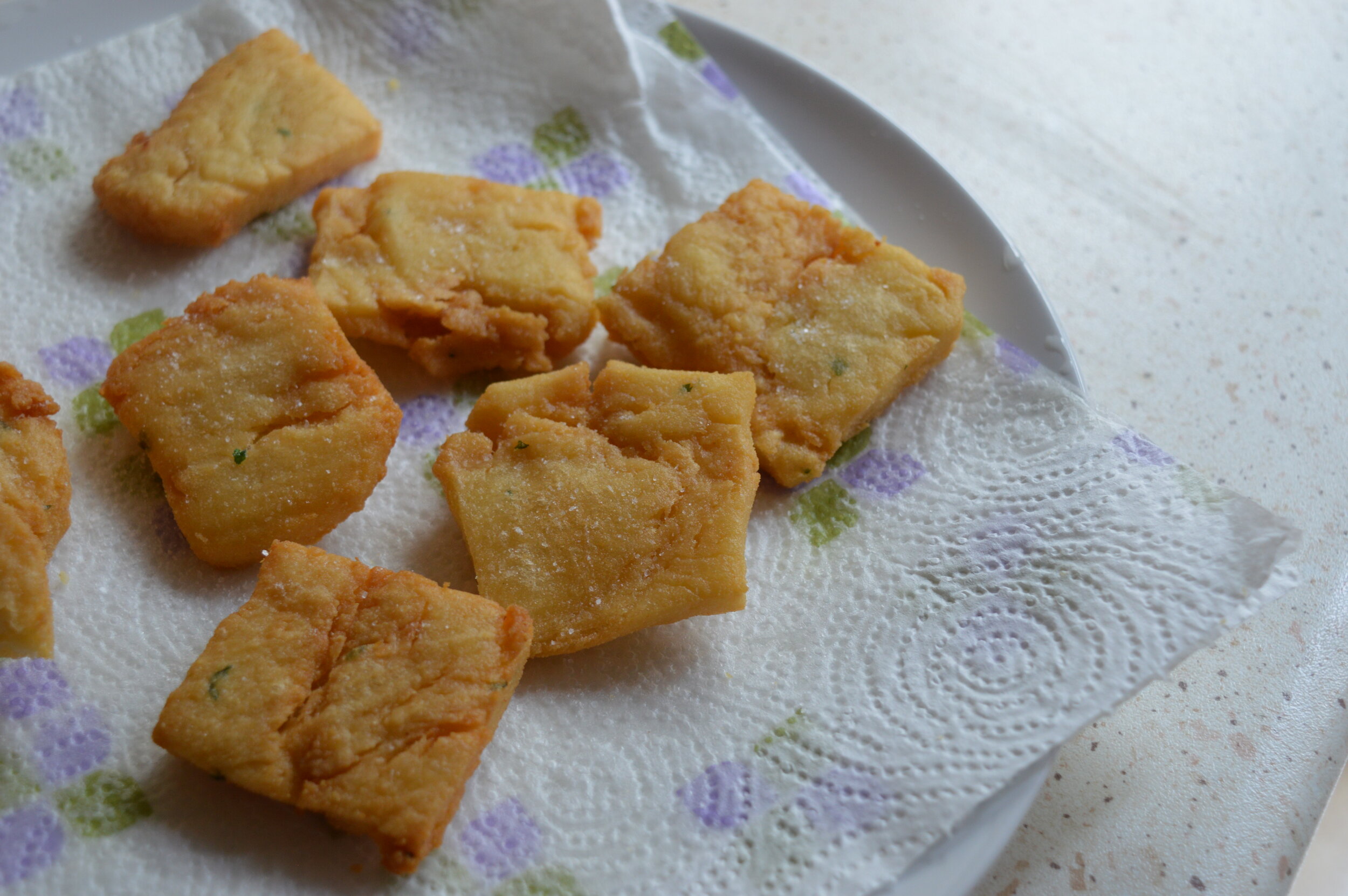Pane e panelle
I may have returned from Sicily six weeks ago now, but — as I predicted — the vacation continues in my kitchen in Rome, where I’ve whipped up sweet-and-sour caponata, fluffy, tomato topped sfincione, and most recently: delectable, delicious pane e panelle.
Like last week’s sfincione, pane e panelle are another example of Sicilian street food and hail from the capital city of Palermo. Panelle are fritters made by cooking chickpea flour with water and salt, polenta-style, that are then mixed with parsley and spread out on a baking sheet to cool, cut in to rectangles, and fried in vegetable oil. Once sprinkled with salt and drizzled with lemon juice, they’re stuffed inside the pane, or bread component, traditionally a sesame seed roll, and are sold by panellari, or panelle vendors. If you want to take your sandwich over the top and do as the Sicilians do, you can opt for pane panelle e crocchè, where fried potato croquettes (!!!) join the panelle party, making for a carb-y, golden, fried paradise of a sandwich. The pane can also be dropped all together the panelle can be enjoyed on their own; in Palermo, they’re served piping hot in a paper cone, to be enjoyed as you stroll through the capital’s streets.
So! As you may recall from this post here, Sicilian cuisine possesses Greek, Spanish, French and Arab influences, traces of the civilizations that occupied the island before it became part of Italy. According to my research it was the Arabs to first grind chickpeas in to flour, which they then cooked with water, spread thin, and baked in bread ovens. It wasn’t until much later during French occupation of Sicily that frying came on to the scene, and Sicilians began to dress up their plain, chickpea pancakes with a pot of bubbling oil and a good dose of salt.
This week I did my best impression of a Sicilian panellaro and tried my hand at homemade pane e panelle, ones that I think any palermitano would approve of. The rolls are soft, sesame-dusted clouds that make the perfect vehicle for the crisp, nutty panelle, their richness cut by a dash of lemon and sprinkle of parsley. They are heavenly in that way that only a mix of bread + fried + salt can be, and can brighten even the dreariest, rainiest Tuesday when you treat yourself to them at lunch — I speak from experience.
A couple of notes: I used a kitchen scale for this recipe (i.e grams) as I find it much more precise — I recommend you do the same, if possible. The bread recipe and panelle recipe can easily be doubled if you are feeding a bigger group — the recipe below will make about 5 rolls. Note the bread also makes a wonderful vehicle for a hamburger or any sandwich filling of your choosing — they freeze well, too. Parsley is the traditional herb used here but I think that rosemary would also be nice. Not traditional in the least, but I did enjoy a dollop of mayonnaise in my panelle sandwich. If you want to make the panelle lighter, bake them for 15 minutes in a 375 degree (190 degree C) oven, with a drizzle of olive oil, broiling them towards the end to make sure that they become nice and brown. Finally, feel free to drop the bread component all together and make just the panelle for a Sicilian starter or snack, if you’d like.
Looking for other Sicilian recipes and posts? I’ve got this post on my travels here, plus this this sfincione, this pesto alla siciliana, this caponata, this granita, and these cannoli.
PANE E PANELLE
Makes 5-6 rolls and 20 panelle.
Bread recipe from La Cuore Della Cucina. Panelle recipe slightly adapted from Tavolarte Gusto.
Ingredients for the pane:
325 grams (2 1/2 cups) all-purpose flour
10 grams (about 1 tablespoon) vegetable oil
240ml (1 cup) water
25ml (about 2 tablespoons) olive oil
2 grams (about 3/4 teaspoon) dry yeast
6 grams (1 teaspoon) salt
2 grams (1/2 teaspoon) sugar
3 grams (1/2 teaspoon) honey
Water & oil for brushing
Sesame seeds
Ingredients for the panelle:
300 grams (1 1/4 cups) chickpea flour
900 grams (3 3/4 cups) water
1 tablespoon finely chopped parsley
6 grams (1 teaspoon) salt
Vegetable oil for frying
A few squeezes of lemon juice
Salt for sprinkling
Directions for the pane, bread:
Pour about 120mL (1/2 cup) of the water in large bowl and add the yeast. Leave for 5 minutes, or until the yeast is foamy. Add the sugar and honey and mix. Next, add the flour a little at a time, stirring well. Add about 60mL (1/4 cup) water, then add both oils a little at a time. Mix in the salt. If the dough seems dry (it probably will) add the other 60mL (1/4 cup) of water and mix, and if it still seems dry, add more water by the tablespoon. Squeeze the dough a little to get the water mixed in, and turn it out on to a lightly floured surface and start to knead the dough. Knead the dough for 12 or so minutes, or until the dough is smooth, elastic, and no longer sticky. Note that if you have a standing-mixer, you can also let the dough hook do the work here. In either case, form a ball and let the dough rise in a large, greased bowl, covered, for two hours in a warm place.
When the two hours are up, form the dough into smaller portions (about 100 grams each). Make each portion into a ball, and flatten it slightly on the top. Place all of the rolls on a baking sheet lined with parchment paper, and cover them with plastic wrap. Let them rise again for 30 minutes.
Preheat the oven to 350 degrees Fahrenheit (170 degrees Celsius). Whisk together a splash of water and olive oil in a bowl. Brush this emulsion mixture on all of the dough buns, and then sprinkle them generously with sesame seeds. Bake the pane for 20-25 minutes, or until golden brown. Let cool completely, then fill with panelle.
For the panelle: Pour the chickpea flour and salt into a pot and whisk together. Next, add the water a little at a time, whisking constantly, until you have a smooth batter. Place the pot on a stove over medium heat, and whisk constantly again for a few minutes, until you have a sort of polenta-like mixture that pulls away from the sides of the pot – it should be compact and not liquid-y. Add the parsley and stir well. Next, spread the mixture out on a baking sheet lined with parchment paper and smooth out with a knife until it is about 5 mm thick. Let the mixture cool to room temperature. Next, cover the top of the mixture with parchment paper, and roll out the mixture slightly, just to make sure that the panelle mix is flat and even. Cut the panelle out with a rectangular cookie cutter (or any other shape you want) or with a knife. Note that they do not have to be perfect — mine were a bit uneven but let’s chalk it up to rustic!
Heat a pot of vegetable oil over a large pot over medium heat until it reaches about 350 degrees Fahrenheit (70 degrees Celsius) on a frying thermometer. Fry the panelle a few at a time in a pot of oil hot until golden brown and crisp — this will take a few minutes. Let them drain on a paper-towel lined plate. Sprinkle with salt, drizzle with lemon juice, and stuff into your sesame roll. Enjoy, pretending your on the streets of Palermo.








